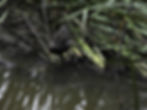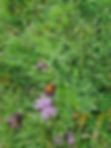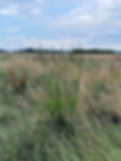Ditchling Common. Wild flowers, lichen, bryophytes and butterflies 08.07.23
- Sim Elliott
- Jul 8, 2023
- 6 min read
Updated: Jul 15, 2023
Ditchling Common is an SSSI with a remarkable range of botanical and insect diversity.
I travelled to Ditchling Common Country Park by train to Burgess Hill and walked to the Common. Ditchling Common is not very close to Ditchling - it is closer to Burgess Hill and Wivelsfield than the village of Ditchling. Trains to and from Burgess Hill/Hassocks are typically every 15 minutes and it is a 10 minute journey to Burgess Hill from Brighton. It takes 45-60 minutes to walk from Burgess Hill Station to Ditchling Common.

After walking around the common I walked south in the Sussex Counties Path to Ditchling, then walked along the footpath to Clayton and got the train back to Brighton from Hassocks. and about 1 to 2 hours to talk from Ditchling Common to Ditchling (depending on much time you spending looking at plants and insects!, and about 45 minutes to walk from Ditchling to Hassocks Trains station.

All sections of text in italics are quotations, sources sited.
The photographs in this post are presented chronologically (in the order in which I saw things)
I am only an amateur naturalist; thus all identifications are provisional; if you note a mistake in identification please feel free to tell me. If you want to contact me about any aspect of this blog, email me at simeon[underscore]elliott[at]gmail[dot]com.
The SSSI citation:
This site on Weald Clay contains a range of grassland types which have resulted from the wide variation in drainage conditions. The flora includes a number of locally uncommon plants. Variable drainage and past management of the site have led to a diversity of habitats. An acidic heath grassland dominates but ungrazed areas consist of bracken, scrub and woodland. Streams dissect the site, although all but one are seasonally dry, and there is a small pond. Butterfly and moth populations are of importance and the site is locally valuable for breeding birds. Five types of acidic heath grassland can be distinguished on the basis of variation in drainage.
a) On poorly drained soils tussock grass Deschampsia cespitosa and rushes Juncus species dominate with lesser spearwort Ranunculus flammula and the locally uncommon spiny rest-harrow Ononis spinosa also present.
b) Tussock grass is dominant on slightly drier ground with abundant devils-bit scabious Succisa pratensis and dyer’s greenweed Genista tinctoria.
c) This type, although drier than types ‘a’ and ‘b’ is damp grassland. It supports a rich flora dominated by Yorkshire fog Holcus lanatus, common bent Agrostis capillaris and smaller cat’s tail Phleum bertolonii. A number of locally uncommon plants occur including ribbed sedge Carex binervis, flea sedge Carex pulicaris, marsh plume thistle Cirsium dissectum, pepper saxifrage Silaum silaus, bitter vetch Lathyrus montanus and the only East Sussex location for tawny sedge Carex hostiana.
d) Dry ground is dominated by false oat grass Arrhenatherum elatius with associated herbs including dyer’s greenweed and fleabane Pulicaria dysenterica.
e) Free draining ground is dominated by bracken Pteridium aquilinum with an associated flora of bluebells Hyacinthoides non-scripta, wood avens Geum urbanum, early purple orchid Orchis mascula and columbine Aquilegia vulgaris. Belts of gorse Ulex europaeus occupy dry, ungrazed areas, while a more diverse scrub occurs in wetter parts and includes hawthorn Crataegus monogyna, blackthorn Prunus spinosa and sallow Salix cinerea.
Wet woodland is dominated by sallow with Pedunculate oak Quercus robur while a small area of mature, dry woodland is of oak, beech Fagus sylvatica and holly Ilex aquifolium. The permanent stream supports a bankside flora of wild angelica Angelica sylvestris and meadowsweet Filipendula ulmaria while the pond has peripheral stands of yellow flag Iris pseudacorus and lesser reedmace Typha latifolia.
The butterfly and moth fauna is rich and contains several uncommon species including four moths associated with dyer’s greenweed and two woodland butterflies, small pearl bordered fritillary and green hairstreak. The areas of woodland and scrub are locally valuable for breeding birds such as willow warbler, blackcap, whitethroat, linnet and yellow hammer.
From Wikipedia:
The Country Park is well known for its spring time display of bluebells, but unlike most bluebell displays that are usually protected by a leafy tree canopy, here the bluebell are sheltered by bracken. There is still petty whin, meadow thistle, bitter vetch, saw wort, dyer's greenweed, heath bedstraw, tormentil, betony and devil's bit scabious. There are also many orchids including heath spotted and common spotted orchid and a kaleidoscope of hybrids. It is one of the few truly native sites for wild columbine flowers and ling heather clings on.
There are still rarities too including narrow buckler and adders tongue ferns, pignut, and the little heath milkwort.[3] In springtime there are emperor moths, in summer, there are green and purple hairstreak butterfly and in 2017 a well established colony of the rare and elusive black hairstreak butterfly was discovered that is thought to have existed undetected for some time.
The commoners' Common is the only part where the character of the original common is maintained and there is still a sense of landscape-scale openness. The biodiversity of the western part survived the farmers intent on ploughing and fertilising the grassland in the decades following the second world war. Now the Commoners Association do important work to save the area's biodiversity. Cattle grazing and scrub control are systematic and regular and as a result the old vegetation is still intact. There is a mosaic of tufted hair grass and purple moor grass, tormentil and dyer's greenweed, with low clumps of dwarf and European gorses, some thorn scrub, and a few super-special 'lawns' of rare marsh plume meadow thistle, with accompanying least willow, spring, carnation and glaucous sedges and quaking grass. On the marshy winter grassland, snipe are still visitors. In late summer large serotine bats forage and the forest specialist's Bechstein's and Barbastrelle bats are also present across both parts of the Common.[3]
Despite the richness of today's Common, much has been lost. Nightingales used to breed here, but no longer. On both the commoners' Common and the Country Park, the closely related sub-shrubs Dyer's greenweed and petty whin were host to dependant populations of at least seven rare micro-moths, which were the chief fame of the Common to lepidopterists. Most, if not all of the micromoths, are now gone, but their evocative names, such as large gold case bearer, the greenweed leaf miner, the greenweed flat body, and the petty whin case bearer, are remembered. Also gone are the rare tawny and flea sedges, starfruit at the pond, and silver studded blue and small pearl-bordered fritillary butterflies. The marsh fritillary is also gone despite many reintroductions attempts between 1960 and 1991. Ditchling Common - Wikipedia Much of the information cited in this article comes from [3] Bangs, David (2018). THE LAND OF THE BRIGHTON LINE: A Field Guide to the Middle Sussex and Southeast Surrey Weald. Farlington, Portsmouth: Bishops Printers
From the entrance to the pond
Meadow Brown

Lesser Stichwort, Stellaria graminea

Common Bird's-foot Trefoil, Lotus corniculatus

Selfheal, Prunella vulgaris

White Clover, Trifolium repans

Wood Dock, Rumex sanguineus

Yorkshire Fog. Holcus lanatus

Marsh Thistle. Cirsium paulstre

Compact Rush, Juncus conglomeratus

Elmleaf Blackberry, Rubus ulmifolius

Hemp Agrimony, Eupatorium cannabinum


Rosebay Willowherb, Chamaenerion angustifolium

Common Cat's-Ear, Hypochararis radicata

Toad Rush, Juncus bufonius

Common Feather-Moss, Kindbergia praelonga

The Pond

A "Bouquest" of grasses, rushes and plantians

Ribwort Plantain, Plantago lanceolata

Common Bent, Agrostis capillaris

Soft Rush, Jumcis effusus

I decided to examine the bryophytes (lichen and bryophytes (mosses and liverworts)) on an Pedunculate Oak, Quercus robur by the pond. On a countryside walk I'll often examine or trees and try to identify all the epiphytes on them
Pedunculate Oak


Common Greenshield Lichen, Flavoparmelia caperata

ShadoowGreenshield Lichen, Flavoparmelia sorediens

Golden Shield Lichen, Xanthoria parietina

Oakmoss, Evernia prunastri on the top of branch - other lichens photographed separately

Farinose Cartlidge Lichen, Ramalina farinacea

Wood Bristle Moss, Othotrichum affine

Forked Veilwort, Metzgeria furcata (liverwort)

Flat-leaved Scalewort, Radula complanta (liverwort)


Walking round the main area of heathland

Dyer's Greenweed, Genista tinctoria

A small deciduous shrub of calcareous grassland, rough pastures and old meadows, calcareous mires (with Schoenus nigricans), grass-heaths, cliffs, road verges, stream banks, woodland rides and field edges on heavy nutrient-poor soils, usually calcareous to slightly acidic clays. Predominantly lowland,
G. tinctoria declined considerably in the second half of the 20th century, mainly through the destruction or agricultural improvement of old meadows and pastures. Undergrazing or neglect, and also overgrazing by sheep, have contributed to further losses since 2000, and it is now a rare sight in many counties, and possibly only abundant in unimproved chalk grasslands in southern England. Genista tinctoria L. in BSBI Online Plant Atlas 2020

Betony, Betonica officicialis

Gorse, Ulex erupaeus

Ragowrt, Jacobaea vulgaris

Smooth Hawksbeard, Crespis capillaris

Small Skipper, Thymelicus sylvestris

White Clover, Trifolium repens

Meadow Brown, Maniola jurtina

Probably Lasioglossum sp. bee


Sharp-flowered Rush, Juncus acutiflorus

Red Admiral, Vanessa atalanta

Back at the pond
European Carp, Cyprinus carpio

Lesser Burdock, Arctium minus

Moorhen, Gallinula chloropus

A family of Mallards, Anas platyrhynchos; parent guarding sleeping juveniles

Small Skipper on Scabious

Tufted Vetch, Vicia cracca

Great Willowherb, Epilobium hursutum

Creeping Thistle, Cisium arvense


Broad-leaved Dock, Rumex obtusifolius

Gatekeeper

Purple-Loosestrife, Lythrum salicara

7-Spot Ladybird, Coccinella septempunctata

Cat's-Ear, Hypochaeris radicata

Perennial Sow Thistle, Sonchis arvensis

Enchanter's Nightshade, Circae luteliana (in the woods

The Sussex Borrders Path to Ditching Village
Common Fleabane, Pulicaria dysenterica


Marbled White on Creeping Thistle, Cirsium arvense

Small/Essex Skipper, Thymelicus sylvestris/lineola on Purple Loosestrife, Lythrum salicaria

Sweet vernal-grass, Anthoxanthum odoratum

Compact Rush, Juncus conglomeratus

Common Red Soldier Beetle, Ryagonycha fuva on Creeping Thistle aka Bonking Beetles Country diary: It’s a summer of love for the red soldier beetle | Insects | The Guardian

Essex Skipper, Thymelicus lineola on Yorkshire Fog, holcus lanatus

Rumex crispus, Curled Dock, on the Low Weald, with the South Downs in the background. East Sussex.



and the world did reveal itself, in the form of one of the smallest flowering plants in the UK, just on the other side of the stile: Geranium dissectum, Cut-leaved crane's-bill.


Gatekeeper, aka Hedge Brown, Pyronia tithonus on possibly Mespilus germanica, Medlar

Meadowsweet, Filipendula ulmaria




Mallard, Anas platyrhynchos, parent guarding sleeping juveniles on Ditchling Village pond

Timothy, Phleum pratense, on the meadow between Ditchling and Keymer

